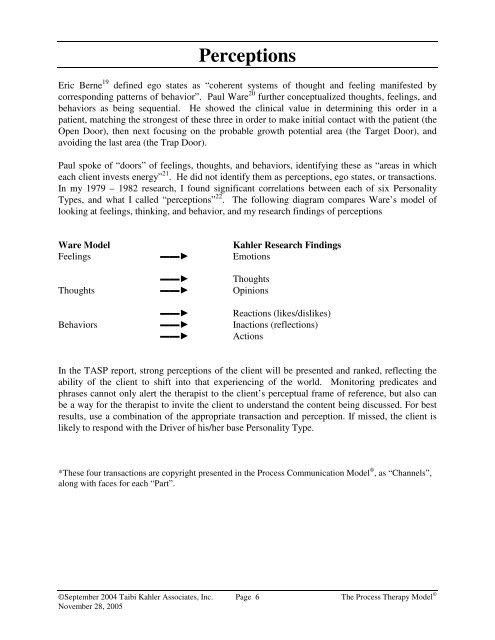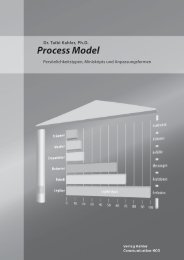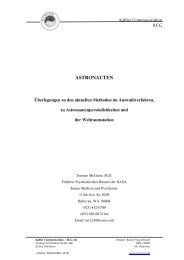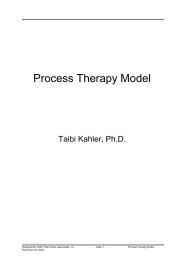Process Therapy Model - bei Kahler Communication
Process Therapy Model - bei Kahler Communication
Process Therapy Model - bei Kahler Communication
Create successful ePaper yourself
Turn your PDF publications into a flip-book with our unique Google optimized e-Paper software.
Perceptions<br />
Eric Berne 19 defined ego states as “coherent systems of thought and feeling manifested by<br />
corresponding patterns of behavior”. Paul Ware 20 further conceptualized thoughts, feelings, and<br />
behaviors as <strong>bei</strong>ng sequential. He showed the clinical value in determining this order in a<br />
patient, matching the strongest of these three in order to make initial contact with the patient (the<br />
Open Door), then next focusing on the probable growth potential area (the Target Door), and<br />
avoiding the last area (the Trap Door).<br />
Paul spoke of “doors” of feelings, thoughts, and behaviors, identifying these as “areas in which<br />
each client invests energy” 21 . He did not identify them as perceptions, ego states, or transactions.<br />
In my 1979 – 1982 research, I found significant correlations between each of six Personality<br />
Types, and what I called “perceptions” 22 . The following diagram compares Ware’s model of<br />
looking at feelings, thinking, and behavior, and my research findings of perceptions<br />
Ware <strong>Model</strong> <strong>Kahler</strong> Research Findings<br />
Feelings ▬▬► Emotions<br />
▬▬► Thoughts<br />
Thoughts ▬▬► Opinions<br />
▬▬► Reactions (likes/dislikes)<br />
Behaviors ▬▬► Inactions (reflections)<br />
▬▬► Actions<br />
In the TASP report, strong perceptions of the client will be presented and ranked, reflecting the<br />
ability of the client to shift into that experiencing of the world. Monitoring predicates and<br />
phrases cannot only alert the therapist to the client’s perceptual frame of reference, but also can<br />
be a way for the therapist to invite the client to understand the content <strong>bei</strong>ng discussed. For best<br />
results, use a combination of the appropriate transaction and perception. If missed, the client is<br />
likely to respond with the Driver of his/her base Personality Type.<br />
*These four transactions are copyright presented in the <strong>Process</strong> <strong>Communication</strong> <strong>Model</strong> ® , as “Channels”,<br />
along with faces for each “Part”.<br />
©September 2004 Taibi <strong>Kahler</strong> Associates, Inc. Page 6 The <strong>Process</strong> <strong>Therapy</strong> <strong>Model</strong> ©<br />
November 28, 2005





